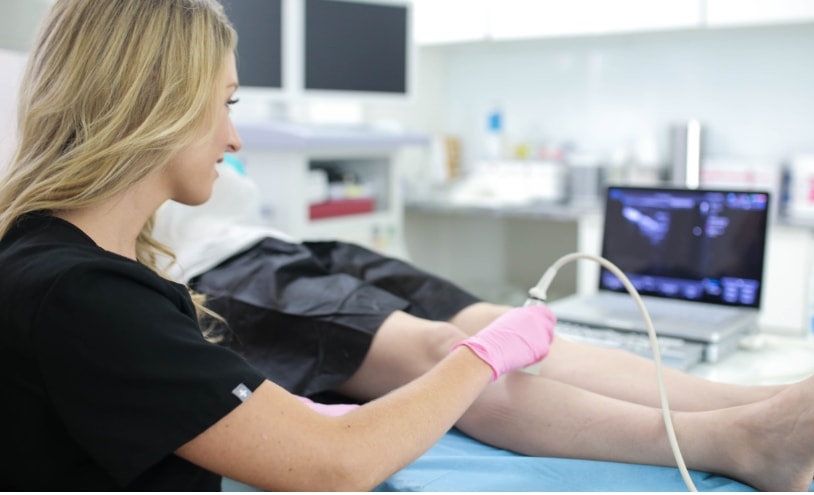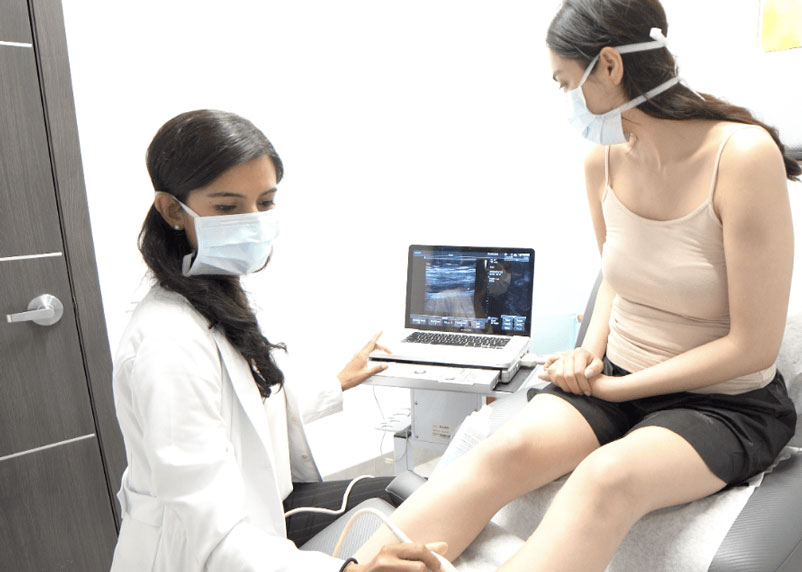Is vein mapping painful?
Vein mapping is a non-invasive procedure that uses sound waves to create a three-dimensional image of the blood vessels in the body. This image is then used to determine the best treatment options for the patient. Your vein doctor examines the direction of blood flow in your leg veins to determine if you have chronic venous insufficiency, deep vein thrombosis, or other medical conditions necessitating treatment. Vein mapping also allows them to curate a personalized vein treatment plan for you.

Chronic venous insufficiency (CVI) occurs when the valves in the veins of the legs are not functioning properly. This can cause the veins to become enlarged and twisted. CVI can also cause swelling and pain in the affected area, spider veins, varicose veins, skin discoloration, and deep vein thrombosis. DVT occurs when blood clots form in the deep veins of the body. DVT can cause the blood clots to travel to the lungs, leading to a potentially fatal pulmonary embolism.
Vein mapping allows our vein doctors to diagnose underlying chronic venous insufficiency, deep vein thrombosis, and other vein problems.

What should I wear during my vein mapping session?
If you’re scheduled for a vein mapping session, you may be wondering what to wear. The good news is that there’s no need to dress up for the occasion. In fact, it’s best to dress in comfortable, loose-fitting clothing.
Why? Because during the vein mapping session, sound waves will be used to create images of your blood vessels. In order to get a clear picture, the technician will need to be able to see your skin, so you’ll have to pull back clothing from the targeted areas.
So, there are three things to keep in mind when choosing what to wear for your vein mapping session: comfort, loose-fitting clothing, and easy access to the veins.
How long does it take to do vein mapping?
Vein mapping is a non-invasive diagnostic procedure used to diagnose chronic venous insufficiency (CVI). This condition is characterized by the pooling of blood in the leg veins, which can lead to leg pain, leg swelling, spider veins, varicose veins, and ulcers. Vein mapping is typically done using Doppler ultrasound, which uses sound waves to create a picture of the blood vessels. The procedure is painless and takes about 30 minutes to complete.
What happens during vein mapping?
During vein mapping, the technician will apply a special gel to the skin and then place the ultrasound wand over the area of concern. The wand will emit sound waves that will bounce off the blood vessels and create an image on a monitor.
The vein doctor will then look for any abnormal areas, such as blockages or valves that are not functioning properly. Once the cause of CVI is determined, treatment can be started. Treatment options include lifestyle changes, such as wearing compression stockings and elevating the legs when possible, and minimally invasive vein treatment options, such as radiofrequency ablation, endovenous laser ablation, and venaseal.
Why do doctors map veins?
Doctors map veins to understand what is happening with a patient’s blood vessels. By looking at the veins, doctors can see how blood is flowing and if there are any blockages. This information helps doctors to understand why a patient may be experiencing pain and swelling, and can help to diagnose the root cause of vein problems. It can also help them curate personalized minimally invasive vein treatment plans for chronic venous insufficiency, varicose veins, spider veins, deep vein thrombosis, and other vein problems.
Can you see a blood clot in an ultrasound?
Deep vein thrombosis (DVT) is a blood clot that forms in a vein, often in the leg. It can cause pain and swelling, and can be dangerous if the clot breaks free and travels to the lungs. Doppler ultrasound is a medical imaging technique that uses sound waves to create pictures of the inside of the body and show how blood is flowing through the blood vessels. It can show the presence of clots in the blood vessels and diagnose DVT or chronic venous insufficiency.
If I’m diagnosed with vein disease, what are my minimally invasive treatment options?
If you’re diagnosed with chronic venous insufficiency, the vein doctor will curate a personalized minimally invasive vein treatment plan. Your treatment options may include radiofrequency ablation, endovenous laser ablation, venaseal, ambulatory phlebectomy, and sclerotherapy.
- Radiofrequency Ablation: Radiofrequency ablation (RFA) is a minimally-invasive procedure that uses heat energy to destroy the diseased vein and restore optimal blood flow to the heart.
- Endovenous Laser Ablation: Endovenous laser ablation (EVLA) uses laser energy to destroy the diseased vein and restore optimal blood circulation.
- Venaseal: Venaseal is a minimally-invasive procedure that uses a medical adhesive to seal the diseased vein, turning it into a hardened tissue absorbed by the body.
- Ambulatory Phlebectomy: Ambulatory phlebectomy is a minimally-invasive procedure that removes the diseased vein through tiny incisions in the skin. This procedure is ideal for superficial varicose veins after the primary vein treatment.
- Sclerotherapy: Sclerotherapy is a minimally-invasive procedure that involves injecting a sclerosant solution into the diseased vein to make the spider veins shrink and dissolve.
The best treatment for you will depend on the severity of your condition and your personal preferences. The vein doctor will discuss all of your options with you and help you make the best decision for your situation.









